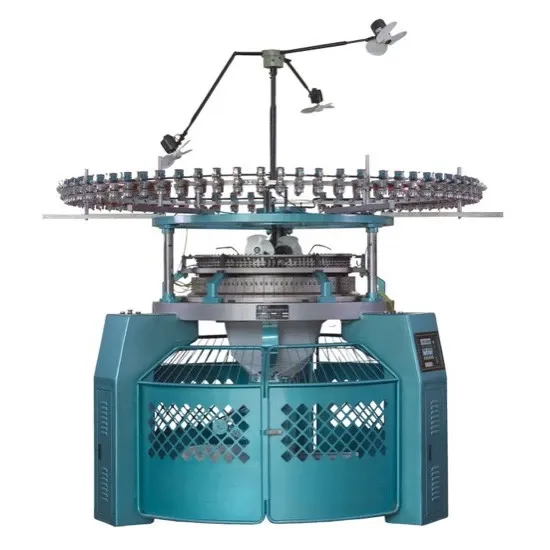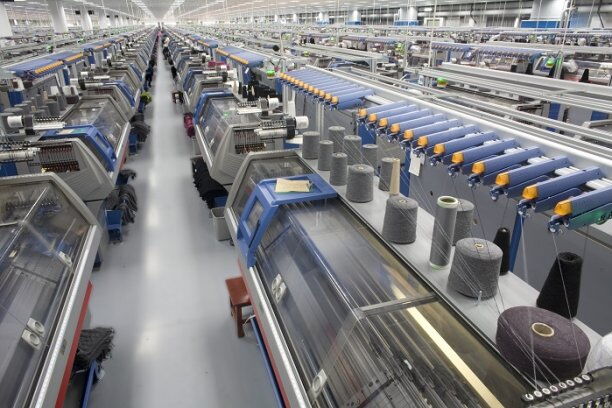What is the Difference Between Circular and Flat Knitting Machines?
Dec 22, 2024
Knitting machines are integral to the textile industry, allowing manufacturers to produce fabric quickly, efficiently, and in varying designs. Among the most commonly used types of knitting machines are circular knitting machines and flat knitting machines. Each type serves a different purpose and has distinct advantages and limitations depending on the requirements of the fabric being produced. In this article, we’ll explore the differences between these two types of knitting machines, their design and functionality, applications, and the pros and cons of each.
As the name suggests, circular knitting machines operate in a continuous circular motion. These machines are primarily designed for high-volume production of tubular fabrics, making them ideal for the manufacturing of garments such as T-shirts, jersey fabrics, and sportswear. Unlike flat knitting machines, which move needles horizontally and vertically, circular machines use a circular needle bed to produce continuous tubular fabrics, making them highly efficient for bulk fabric production.

Circular knitting machines consist of a cylinder, often referred to as the knitting head, which holds numerous rows of needles arranged in a circular formation. Yarn is fed into the needles through a combination of sinkers and guides. As the cylinder rotates, the needles work to form a continuous tube of fabric. The knitting head, rotating in a 360-degree motion, creates the fabric in a seamless manner, ideal for products that require uniform, continuous stretches of fabric.
The yarn feeding system and the movement of the needles within the machine are designed to handle high speeds, making circular knitting machines excellent for mass production. The yarn is knitted into fabric in a seamless, continuous loop, which is then spooled off or cut into desired lengths.
Circular knitting machines are primarily used for the production of fabrics intended for apparel, particularly T-shirts, leggings, sportswear, and hosiery. Their ability to create tubular fabrics makes them perfect for products like socks and tights, which require seamless construction. They are also used in the production of elastic fabrics, as the continuous knitting process allows for stretchable and flexible material to be manufactured at high speeds.
Other applications include the production of fabrics used in medical textiles (e.g., compression garments) and technical textiles, where high-speed and precision fabric manufacturing are essential. The machines are also used in the creation of geotextiles and industrial fabrics.
Circular knitting machines are designed to run at very high speeds, allowing for the production of large quantities of fabric in a short amount of time. This makes them ideal for bulk manufacturing, where high-volume production is a priority.
These machines produce seamless fabrics, reducing the need for additional processing steps like stitching or seam sealing. This makes them particularly suitable for manufacturing tubular products such as socks and jerseys.
Circular knitting machines can produce fabric continuously, eliminating the need for joining separate panels together, which is especially useful for garments like T-shirts and leggings that require smooth, seamless construction.
While circular knitting machines excel at creating fabric with overall patterns or textures, they are less adept at producing intricate, detailed designs. For complex patterns, flat knitting machines may be the better choice.
Circular knitting machines generally consume more yarn than flat knitting machines due to the continuous nature of the fabric being produced. This can lead to higher material costs and potential waste.
Although circular machines are efficient for basic garment manufacturing, they may not be suitable for specialized fabrics or designs that require intricate patterns or color variations, where flat knitting machines excel.
Flat knitting machines are known for their flexibility and versatility, allowing manufacturers to produce a wide range of complex designs, patterns, and fabrics. These machines operate by moving needles horizontally and vertically, fixing yarn to a flat surface to form fabric panels. This makes them ideal for manufacturing fabric that requires more precise control over pattern formation and design intricacy.

Flat knitting machines typically consist of a needle bed, carriage, and guides. The needle bed features numerous narrow slots or grooves where the needles are inserted. The carriage moves horizontally across the needle bed, while the guides feed the yarn into the needles. The movement of the needles and the yarn guides is controlled via a cam system or computer control, allowing for precise control over the creation of patterns.
Each needle is manipulated individually, enabling the production of fabric with highly specific and intricate designs. This means that flat knitting machines are particularly well-suited for creating garments and textiles with detailed patterns, textures, and varying colors.
Flat knitting machines are used across a broad range of applications, from fashion to home textiles. Some common uses include:
Flat knitting machines are widely used for producing sweaters, shawls, dresses, and scarves, allowing for the creation of highly detailed and intricate patterns.
These machines are also capable of producing seamless garments, which are increasingly popular in fashion for their comfort and clean appearance.
Flat knitting machines are used to create home decor items like blankets, cushion covers, and upholstery fabric.
Similar to circular machines, flat knitting machines can be used to produce industrial textiles used in applications like automotive interiors, medical textiles, and technical fabrics.
With their ability to create highly flexible, form-fitting fabrics, flat knitting machines are used in the production of sportswear and activewear that require intricate designs and flexible, stretchable materials.
One of the greatest advantages of flat knitting machines is their ability to produce complex designs and intricate patterns. Whether creating detailed colorwork, textured patterns, or specialty fabric types, flat knitting machines are unmatched in their design flexibility.
Flat knitting machines are designed to minimize yarn wastage. Since the yarn is fed directly into the needles, the machines use less material than circular knitting machines, reducing overall production costs.
With advances in computer-controlled technology, flat knitting machines are relatively easy to operate, making them suitable for both skilled craftsmen and beginners in the textile industry.
These machines are capable of producing fabrics with varying textures, weights, and patterns, which makes them perfect for the fashion industry, especially when the production of unique, high-quality garments is required.
Unlike circular knitting machines, which produce continuous fabric in wide rolls, flat knitting machines are limited to narrower fabric widths. This makes them less suitable for large-scale, mass-market garment production.
Due to the level of control required for creating intricate patterns, fabric production on flat knitting machines can be slower than on circular machines, especially when creating large panels or highly detailed designs.
While they excel at intricate designs, flat knitting machines can become more complex and less cost-effective for mass production when compared to circular knitting machines.
In summary, circular knitting machines and flat knitting machines each offer distinct advantages and limitations. Circular knitting machines are best suited for high-speed, mass production of tubular fabrics, ideal for garments like T-shirts and leggings. They are highly efficient but may lack the ability to produce intricate patterns or detailed designs. On the other hand, flat knitting machines offer exceptional design flexibility, enabling the creation of complex patterns and intricate designs, but they come with limitations such as narrower fabric width and slower production speeds.
Choosing between these two types of knitting machines depends largely on the specific needs of the manufacturer, including factors like fabric design, production speed, material costs, and the type of end product being produced. Each machine has its place in the textile industry, and understanding their differences is key to optimizing production processes and meeting the demands of diverse fabric applications.
Next: Single Jersey Three Thread Fleece Circular Knitting Machine: Tailored for the Egyptian Market
Previous: How to Choose Cams for Circular Knitting Machine Parts
We have been committed to manufacturing all types of circular knitting machines with great quality and reasonable price for a long time. Our professional team is highly specialized and problem-solving oriented. We put the most effort into meeting your knitting demands, achieving a win-win situation.